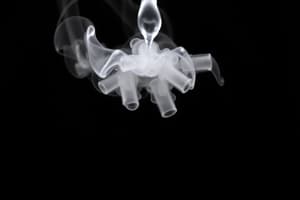Podcast
Questions and Answers
What does Raoult's Law state?
What does Raoult's Law state?
- The vapor pressure of a solution is inversely proportional to the mole fraction of the solvent.
- The vapor pressure of a solution is directly proportional to the mole fraction of the solvent. (correct)
- The vapor pressure of a solution is highest when the solute concentration is at its peak.
- The vapor pressure of a solution is independent of the solvent present.
How does the vapor pressure change as the mole fraction of the solvent increases?
How does the vapor pressure change as the mole fraction of the solvent increases?
- Vapor pressure increases (correct)
- Vapor pressure remains constant
- Vapor pressure decreases
- Vapor pressure becomes unpredictable
What factor determines the contribution of each component (solvent and solute) to the overall vapor pressure?
What factor determines the contribution of each component (solvent and solute) to the overall vapor pressure?
- Mole fraction of the solute
- Size and shape of the particles
- Temperature of the system
- Number of particles in the system (correct)
What happens to the vapor pressure as the concentration of solvent decreases?
What happens to the vapor pressure as the concentration of solvent decreases?
How is the total vapor pressure of a binary mixture calculated according to Raoult's Law?
How is the total vapor pressure of a binary mixture calculated according to Raoult's Law?
What does the mole fraction of a solvent represent in a solution?
What does the mole fraction of a solvent represent in a solution?
Study Notes
Vapor pressure is the pressure exerted by a vapor above its own condensed phase. It describes how much of the vapor will evaporate from a liquid when it reaches equilibrium with the surrounding gaseous environment. This concept is important because it governs qualities such as boiling points and osmotic pressures.
Raoult's Law is a fundamental principle related to vapor pressure. Named after French chemist François Marcellin Robert Henry Raoult, this law states that the vapor pressure of a solution is directly proportional to the mole fraction of solvent present in the solution. In other words, if you have a solution where a solvent X mixes with solute Y, the vapor pressure of this mixture is given by:
Vapor Pressure = P_X * x_molar(X)
where:
- Vapor Pressure represents the total vapor pressure of the binary mixture.
- P_X is the pure vapor pressure of solvent X.
- x_molar(X) represents the moles of solvent per total moles of the solution, which is called the mole fraction.
This indicates that as the mole fraction of the solvent increases, so does the vapor pressure of the solution. Conversely, as the concentration of the solvent decreases, the vapor pressure also decreases. Additionally, the contribution of each component (solvent and solute) to the overall vapor pressure depends only on the number of its molecules, not their size or shape - it's based purely on the number of particles in the system.
The effect of Raoult's Law can be observed in many practical applications, such as:
- Solubility of nonvolatile liquids: When water evaporates from a saltwater solution, the composition of the vapor remains almost entirely unchanged from that of the original solution.
- Osmosis: Due to differences in pressure between two solutions, water moves from one region to another through semipermeable membranes.
Studying That Suits You
Use AI to generate personalized quizzes and flashcards to suit your learning preferences.
Description
Learn about Raoult's Law, which describes the relationship between vapor pressure and the mole fraction of solvent in a solution. Discover how vapor pressure influences boiling points, osmotic pressures, and other properties of liquids and gases.




